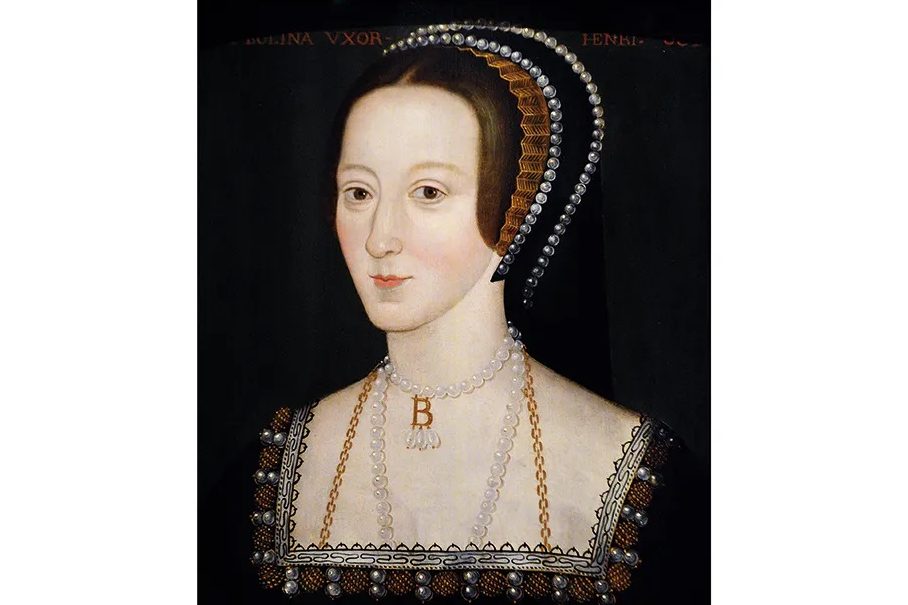“These bloody days have broken my heart.” Thomas Wyatt’s words are an expression of his personal distress at the fall of Queen Anne Boleyn, Henry VIII’s second wife and the woman for whom the king had defied the pope and proclaimed himself supreme head of the English Church.
But they are also indicative of the shockwaves resonating around England in May 1536. Within just three weeks, Queen Anne, along with five men — among them her brother George, with whom she was accused of incest — were tried and convicted of treasonous adultery and beheaded in the Beauchamp Tower. Wyatt himself, narrowly escaping their fate, may have witnessed Anne’s execution from a slit in a window in the Bell Tower. She was swiftly dispatched by a swordsman from Calais. Her corpse and decapitated head were hurriedly consigned to an old arrow chest and buried in the chapel nearby.
The Henrician regime proved extraordinarily successful in erasing Anne from history after her death
Never before had an anointed English queen stood trial, let alone been judicially murdered. As John Guy and Julia Fox point out in Hunting the Falcon, their study of Henry VIII and Anne Boleyn’s relationship (the falcon was Anne’s insignia), the only precedent lay in romantic fiction, in a work that was popular at Henry’s court: Malory’s Le Morte D’Arthur. There, in the story of Guinevere’s condemnation for her love for Lancelot, was the “conceptual basis” for putting a queen on trial.
Subsequently the Henrician regime proved extraordinarily successful in its efforts to erase Anne from history through its wholesale destruction of physical evidence relating to her. Few writings by Anne remain. There is only one authenticated contemporary portrait, a 1534 medal — and that has its nose bashed in. Examine the organ screen in the chapel of King’s College, Cambridge, and look out for a rare survival of the romantically entwined initials “HA” carved in its wood. Onlookers at Anne’s coronation in 1533 — five days of celebration costing eighty million dollars in modern terms — laughed at the cipher emblazoned everywhere and burst out “Ha, ha, ha” as Henry and Anne went by.
Occasionally bits of Boleyn ephemera turn up. In 2019 a metal detectorist uncovered a gold ring with a bull’s head (an obvious pun) that had once been worn by Anne’s father or brother, glinting in the Kent soil. Meanwhile, at Hever, Anne’s childhood home, pages in Anne’s book of hours have been subjected to ultraviolet light revealing the names of a network of her kinswomen intent on keeping the late queen’s memory alive.
However, these are hardly earth-shattering discoveries. The shelves are piled high with books about Anne Boleyn, most of them recycling the same tired old facts or inventing improbable new fictions. We also possess the painstaking scholarship on the subject of the late Eric Ives. So do Guy and Fox — appropriately, a husband and wife team — have anything to add?
The answer is that they unquestionably do. There may still be gaping holes in the story, but their book provides the most cogent narrative reading of the evidence to date. It leaves us in no doubt of the momentous consequences of Henry’s pursuit of Anne Boleyn, the woman who, in Wyatt’s evocative phrase, “set our country in a roar.”
They achieve this by emphasizing the influence of France on the formation of Anne’s personality, her ideas and even on the circumstances of her fall. This they set against the backdrop of international alliances, shifting in Anne’s last months away from France in the direction of Charles V’s Holy Roman Empire.
Sent as a teenager to the French court, Anne encountered two women who had a decisive impact on her developing notions about the ways in which women could exercise power. Guy and Fox are a bit gung-ho about throwing the label “proto-feminist” around. Yet there’s little doubt that the examples of Francis I’s mother, Louise of Savoy, sometime regent of France, and even more of his sister, Marguerite of Angoulȇme, a leading figure in the French Renaissance whose writings later exposed the courtly subordination of women to men, deeply influenced Anne both as political player and patron of the arts.
Returning to England in 1522, at about the age of twenty, as a lady-in-waiting to Queen Katherine of Aragon, Anne must have quickly come to Henry’s attention. Her French chic marked her out. She made the French hood fashionable in place of the dowdy English gable headdress. Striking rather than beautiful, she possessed dark, flashing eyes. However, it was not until 1526 that Henry, despairing of Katherine’s ability to give him a male heir, was “struck with the dart of love,” as he put it, for Anne. For the next six years, throughout the tortuous process of “the King’s Great Matter” — divorcing Katherine in defiance of Rome and eventually marrying Anne — it’s clear that Anne was directing the divorce strategy as an equal partner with Henry.
She also understood the theological debates underpinning the break with Rome perhaps better than he did. Again, French influence was paramount. Anne had absorbed the works of French reformists such as Jacques Lefèvre d’Étaples. Maybe John Foxe later overplayed it when he called Anne one of the twin architects of the English Reformation, together with Thomas Cromwell. Certainly she wasn’t a Lutheran, and looked for reform from within the Catholic Church (there’s no mention here of her staunch rejection of the gift of a book that attacked transubstantiation). But she promoted the vernacular English Bible, owned a copy of Tyndale’s illegal translation and used her position as queen to advance evangelically minded clergy within the church.
In the end, of course, the underlying transactional basis of Henry and Anne’s relationship was exposed. He had made her queen but she hadn’t fulfilled her side of the bargain by giving him a son — only another daughter, Elizabeth. Guy and Fox sensibly reject any suggestion that Anne was guilty of the crimes for which she was executed. These are laid bare as a masterful political coup by Cromwell, though Anne’s flirtatious “French-inspired” behavior in her chamber helped contribute to the trumped-up charges.
The book leaves us with an intriguing question. Was Anne ever truly in love with Henry? Probably not as passionately as he was with her. “If you remember my love in your prayers as strongly as I adore you,” he had written besottedly to her, “I shall hardly be forgotten, for I am yours, Henry R always.” That scalding love turned eventually to brutalizing hatred. When Anne went bravely to the scaffold, was Henry’s sending to Calais for a specialist swordsman a final concession to the love of his life, or a horrible, sardonic reminder of Anne’s love of France?
This article was originally published in The Spectator’s UK magazine. Subscribe to the World edition here.

























